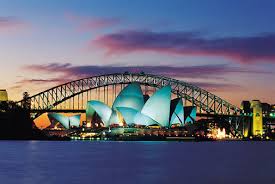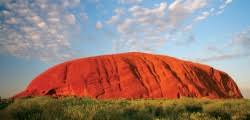Australia: top view
 Australia is a paradoxical place, full of strange, unlike anything else. To begin with, one of its youngest countries is located on one of the oldest existing continents of the world. Moreover, this is the only state that occupies a whole continent and “by land” does not border any other. Compared to Europe, Australia is the least populated part of the world, with 2.5 people per 1 square kilometer. On vast uninhabited territories the most ancient mammals, marsupials, almost unchanged over millions of years, live. Wild jungle encircles coastal areas, and penguins and seals splashing here from capes at the southern end of the mainland swim from Antarctica …
Australia is a paradoxical place, full of strange, unlike anything else. To begin with, one of its youngest countries is located on one of the oldest existing continents of the world. Moreover, this is the only state that occupies a whole continent and “by land” does not border any other. Compared to Europe, Australia is the least populated part of the world, with 2.5 people per 1 square kilometer. On vast uninhabited territories the most ancient mammals, marsupials, almost unchanged over millions of years, live. Wild jungle encircles coastal areas, and penguins and seals splashing here from capes at the southern end of the mainland swim from Antarctica …
Generally speaking, Australia’s paradox is “set” by its very location: in fact, for the inhabitants of the North, it seems involuntarily that in the Southern Hemisphere “the opposite is true”. Hence the nickname of the Green Continent – the land down under, “land upside down.” No, of course, people do not go upside down in Australia, but many of the things familiar to us look different here. The disk of the moon, for example, is really visible “upside down.” June, July and August are officially called winter, and December, January and February – in the summer. It is not surprising that in such a strange place, when moving north it gets warmer, and south it gets colder. Obeying the Coriolis force (the deflecting force of the Earth’s rotation), the waters of the rivers more strongly wash the left banks, and the vortices and sea currents twist clockwise.
According to geologists, the birth of the “Australian phenomenon” began in the Mesozoic, with the supercontinent Gondwana, part of which it was together with Africa, South America, India and Antarctica. Gondwana broke up, and Australia, left alone, slowly began to drift to the north. And the more she moved away from the South Pole, the drier her climate became. Over millions of years of “drought” most of the rivers disappeared from the mainland, and the whole mountains were blown away by winds. Today it is the flattest and “shallowest” continent on Earth, more than half of which has been swallowed by the poisonous red desert, or, as the locals call it, outback (“uninhabited”). There are almost no sources of water inland, a few “cries” – dry riverbeds – are filled with moisture only after occasional rainfall.
But, despite the generally difficult climate and poor soils, Australia has retained an amazing variety of flora and fauna, and the vast majority of species are found only there.
This highly urbanized country, where more than 80% of the population lives in large cities, at the same time maintains a unique balance between man and nature. Megacities merged together with the surrounding bush (shrub zone) and its inhabitants, and local residents are very careful about the surrounding nature, literally considering it to be native. Colorful parrots, bats and huge insects flutter in abundance in the very center of Sydney, and the inscription at the entrance to the Royal Botanic Gardens says: “Please walk on the grass! Sniff the flowers! Hug the trees and talk with the birds!” Animals respond to people in return: twenty million people and forty million kangaroos coexist in perfect harmony …
Australia is the smallest mainland. It can be crossed by air in four hours and by car in a week. But, despite its modest size, its climatic and landscape diversity is as great as everywhere else in the world. In the west and in the center there are huge deserts: Big Sandy, Gibson, Victoria, Simpson. Hundreds of kilometers of deserted spaces, drawn only by the paths of feral camels. Blood-red dunes echo the steppe scorched by the sun, and in the middle of a stone carelessly thrown from heaven rises the Uluru massif, sacred to the indigenous population. In the east, the Great Dividing Range separates desert territories frThe prosperity of Australia, one of the twenty richest countries in the world, depends largely on natural resources and minerals. Thanks to money and an abundance of land, Australians live much more comfortably than Europeans – in large private houses, which are not always locked at night. In their cities and buildings, they embody all the best achievements of modern civilization, while at the same time developing a unique, incomparable architectural style. But people with their cities, cars, and homes are still rare in Australia. Two hundred years is by no means sufficient to populate and master even the smallest mainland.om the fertile coastal lands where Australia’s main cities are located. Tropical jungle, interspersed with eucalyptus groves, stretches along the ridge. From the sea, stretching along the east coast for 2,300 kilometers, lies the Great Barrier Reef – a natural object of world significance and one of the most important biosphere reserves on the planet. It is so large that it is visible even from space. Endless salt deserts and sparkling crystals of a lake generated by the ancient sea occupy the south of the continent. And the unprotected southern coast is cut by the waves of the Indian Ocean into pieces in the form of bizarre cliffs and rocks.
But the most picturesque place in Australia, by all accounts, is the Northern Territory with its virgin nature: waterfalls and impenetrable mangroves, swamps and 7-meter crocodiles. Here, in the Kakadu National Park, the most interesting drawings of the natives are shown in the country.




